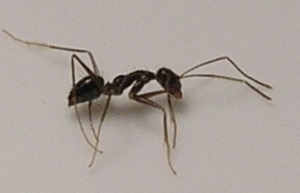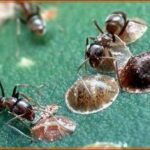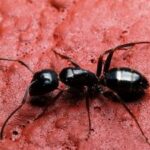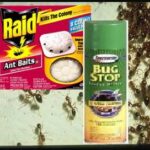Insecticides are toxic to the environment and they should only be used as a last resort inside your home. The chemicals that are used in common ant and roach killers can do harm to you, your family and your pets. They are not environmentally friendly and the containers and spray cans should be disposed of in a hazardous waste facility. Don’t throw them out in the trash where the remaining chemicals leach out into the environment.
Ants
After having a rather severe ant infestation this year, I turned to environmentally conscious friends and my local cooperative extension office for advice on how to get the little buggers out of my home. These ants were extremely persistent and I thought I was going to have to turn to pesticides. However, I found that the following options work very well.
Remove all open food items that are infested with ants. Put all food into sealed containers.
Look for where the ants are entering your home and seal the area with caulk. If they are entering through a window, add weatherstripping.
Vacuum well on a daily basis and immediately discard the bag. If your vacuum does not use a bag, empty the dirt container into a garbage bag, seal it well and put it outside in the trash.
Wash all of your floors, cabinets and counter tops with equal amounts of vinegar and water. You can spray all visible ants with this mixture and it will kill them.
Add one tablespoon of dish washing liquid to one quart of water. Spray the area and any visible ants with this and allow it to dry. It leaves a film but it does deter the ants. This will kill ants if you spray it directly on them.
Sprinkle grits or Cream of Wheat cereal along the ant trails. This works, but it takes a couple of days.
Sprinkle Equal or other aspartame sweetener along the ant trails. Ants will not cross or travel through a line of aspartame.
Roaches
Thankfully I have not had problems with roaches. They are tough to get rid of. Here are some tried and true non-chemical methods of dealing with a roach problem.
Remove all possible sources of food and water. Declutter the area and remove potential hiding places like newspapers and magazines. Seal cracks and crevices with caulk.
Keep the drains covered overnight and when not in use. Cover the disposal in the sink.
Leave cucumber peels out on the counters overnight. Discard them in the morning.
Manually smash or crush any roaches that you see.
Spray the area with several drops of lavender oil or tea tree oil mixed with a quart of water. Allow this to dry.
As a last resort, use boric acid. This is a poison so it is not advisable to use it in the kitchen. Keep pets and children away from any area where boric acid is used. This is not the same as laundry borax.
Fleas
Fleas bite humans as well as animals. You can tell when fleas are a problem, you will notice bites around your ankles and lower legs. The bites can be very annoying to people who are sensitive to them.
Vacuum daily until the infestation is gone. Dispose of the vacuum bag or empty the dirt cup into a sealed bag and discard it outside of the house.
Wash all pet bedding and human bedding. Wash slip covers and throws if your pets are allowed on the furniture. Use the hottest washer and dryer settings that the fabric will allow.
Make your own flea traps. Set a shallow pan of water underneath a night light. In the morning, you will see drowned fleas. Empty the water and replace it until no more fleas are seen.
Add several drops of tea tree oil to your pet’s shampoo. Wash them weekly until the fleas are gone.
Make a flea collar. Use any porous collar (avoid nylon) and soak it with eucalyptus and garlic oil. Allow this to dry and then put it on your pet.
USe a flea comb on your pet to remove fleas and eggs.
Moths
Moths can invade clothing and your pantry. Keeping them at bay is not difficult with these tricks.
Clean wool clothing before storing for the winter. Seal in airtight containers.
Shake out wool rugs on a regular basis. Vacuum rugs and furniture on a regular basis.
Make moth traps out of cardboard and Tanglefoot. Cut cardboard into strips and bend it into a triangle. Straighten out the cardboard and cover the inside of the triangle with Tanglefoot. Tape the triangle closed and hang in closets and pantries.
Hang a pompadour in your closet. Make one with an orange and whole cloves. Use a pencil to poke holes into the orange, place whole cloves in the holes and hang the orange in your closet.
Try these suggestions before heading for the insecticide. They may take a little longer to work than the pesticides do, but in the long-run it will keep your home healthier and chemical free.
More from Associated Content
Controlling Japanese Beetles in your Garden
Inexpensive Homemade Dryer Sheets




